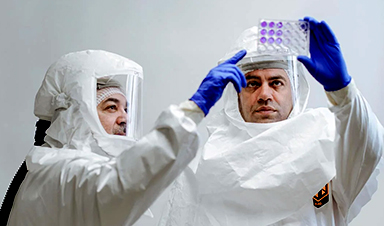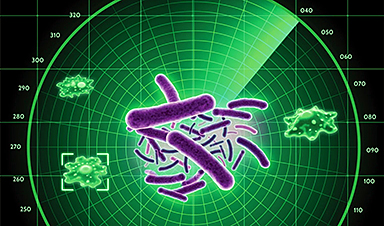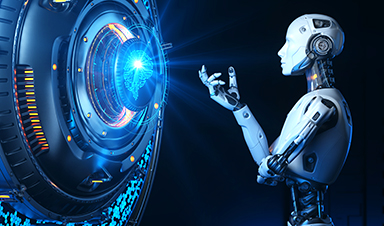Researchers at the Texas Biomedical Research Institute (Texas Biomed) have identified a strain of bird flu isolated from a human in Texas that carries a distinctive set of mutations, making it more adept at replicating in human cells and causing severe disease in mice. This strain was compared to one found in dairy cattle, and the findings are detailed in Emerging Microbes & Infections.
The discovery underscores a significant concern about the H5N1 strains of bird flu currently circulating in the U.S.: the virus’s rapid mutation when it infects a new host species.
H5N1, which is naturally present in wild birds and deadly to chickens, has recently spread to a wide range of mammals and, for the first time in the spring of 2024, began infecting dairy cows.
As of early 2025, the outbreak had spread through herds across multiple states in the U.S. and infected dozens of people, mostly farm workers. So far, most people infected experience mild illness and eye inflammation and the virus is not spreading between people. The first H5N1 death in the U.S. was reported in January 2025 following exposure to infected chickens.
“The clock is ticking for the virus to evolve to more easily infect and potentially transmit from human to human, which would be a concern,” said Texas Biomed Professor Luis Martinez-Sobrido, Ph.D., whose lab specializes in influenza viruses and has been studying H5N1 since the outbreak began last year. The team has developed specialized tools and animal models to test prophylactic vaccines and therapeutic antivirals.
Human vs. bovine
In the recent study, they compared H5N1 strains isolated from a human patient and from dairy cattle in Texas.
“There are nine mutations in the human strain that were not present in the bovine strain, which suggests they occurred after human infection,” Dr. Martinez-Sobrido said.
In mouse studies, they found that compared to the bovine strain, the human strain replicated more efficiently, caused more severe disease, and was found in much higher quantities in brain tissue. They also tested several FDA-approved antiviral medications to see if they were effective against both virus strains in cells.
“Fortunately, the mutations did not affect the susceptibility to FDA-approved antivirals,” said Staff Scientist Ahmed Mostafa Elsayed, Ph.D., first author of the study.
Antivirals will be a key line of defense should a pandemic occur before vaccines are widely available, Dr. Martinez-Sobrido said. This is especially true since humans have no preexisting immunity against H5N1 and seasonal flu vaccines appear to offer very limited protection, according to a separate study conducted in collaboration with Aitor Nogales, Ph.D., at the Center for Animal Health Research in Spain.
Next steps and recommendations
Texas Biomed is now exploring the human H5N1 mutations individually to determine which are responsible for increased pathogenicity and virulence. The team wants to figure out what allows H5N1 to infect such a wide range of mammal species; why H5N1 causes mild disease in cows but is lethal in cats; and why infections via cows are less harmful to people than infections from chickens.
In a third paper, Dr. Elsayed and collaborators analyzed the history of H5N1 in dairy cattle for the journal mBio and called for a One Health approach to protect both animals and people.
“A key priority will be to eradicate bird flu from dairy cows to minimize the risk of mutations and transmission to people and other species,” Dr. Elsayed said. “Steps that can be taken now include thorough decontamination of milking equipment and more stringent quarantine requirements, which will help eliminate the virus more quickly in cows.”
References:
“Replication kinetics, pathogenicity and virus-induced cellular responses of cattle-origin influenza A(H5N1) isolates from Texas, United States” by Ahmed Mostafa, Ramya S. Barre, Anna Allué-Guardia, Ruby A. Escobedo, Vinay Shivanna, Hussin Rothan, Esteban M. Castro, Yao Ma, Anastasija Cupic, Nathaniel Jackson, Mahmoud Bayoumi, Jordi B. Torrelles, Chengjin Ye, Adolfo García-Sastre and Luis Martinez-Sobrido, 8 January 2025, Emerging Microbes & Infections.
DOI: 10.1080/22221751.2024.2447614
“Avian influenza A (H5N1) virus in dairy cattle: origin, evolution, and cross-species transmission” by Ahmed Mostafa, Mahmoud M. Naguib, Aitor Nogales, Ramya S. Barre, James P. Stewart, Adolfo García-Sastre and Luis Martinez-Sobrido, 13 November 2024, mBio.
DOI: 10.1128/mbio.02542-24
“Are we serologically prepared against an avian influenza pandemic and could seasonal flu vaccines help us?” by Iván Sanz-Muñoz, Javier Sánchez-Martínez, Carla Rodríguez-Crespo, Corina S. Concha-Santos, Marta Hernández, Silvia Rojo-Rello, Marta Domínguez-Gil, Ahmed Mostafa, Luis Martinez-Sobrido, Jose M. Eiros and Aitor Nogales, 31 December 2024, mBio.
DOI: 10.1128/mbio.03721-24
News
Measles Is Back: Doctors Warn of Dangerous Surge Across the U.S.
Parents are encouraged to contact their pediatrician if their child has been exposed to measles or is showing symptoms. Pediatric infectious disease experts are emphasizing the critical importance of measles vaccination, as the highly [...]
AI at the Speed of Light: How Silicon Photonics Are Reinventing Hardware
A cutting-edge AI acceleration platform powered by light rather than electricity could revolutionize how AI is trained and deployed. Using photonic integrated circuits made from advanced III-V semiconductors, researchers have developed a system that vastly [...]
A Grain of Brain, 523 Million Synapses, Most Complicated Neuroscience Experiment Ever Attempted
A team of over 150 scientists has achieved what once seemed impossible: a complete wiring and activity map of a tiny section of a mammalian brain. This feat, part of the MICrONS Project, rivals [...]
The Secret “Radar” Bacteria Use To Outsmart Their Enemies
A chemical radar allows bacteria to sense and eliminate predators. Investigating how microorganisms communicate deepens our understanding of the complex ecological interactions that shape our environment is an area of key focus for the [...]
Psychologists explore ethical issues associated with human-AI relationships
It's becoming increasingly commonplace for people to develop intimate, long-term relationships with artificial intelligence (AI) technologies. At their extreme, people have "married" their AI companions in non-legally binding ceremonies, and at least two people [...]
When You Lose Weight, Where Does It Actually Go?
Most health professionals lack a clear understanding of how body fat is lost, often subscribing to misconceptions like fat converting to energy or muscle. The truth is, fat is actually broken down into carbon [...]
How Everyday Plastics Quietly Turn Into DNA-Damaging Nanoparticles
The same unique structure that makes plastic so versatile also makes it susceptible to breaking down into harmful micro- and nanoscale particles. The world is saturated with trillions of microscopic and nanoscopic plastic particles, some smaller [...]
AI Outperforms Physicians in Real-World Urgent Care Decisions, Study Finds
The study, conducted at the virtual urgent care clinic Cedars-Sinai Connect in LA, compared recommendations given in about 500 visits of adult patients with relatively common symptoms – respiratory, urinary, eye, vaginal and dental. [...]
Challenging the Big Bang: A Multi-Singularity Origin for the Universe
In a study published in the journal Classical and Quantum Gravity, Dr. Richard Lieu, a physics professor at The University of Alabama in Huntsville (UAH), which is a part of The University of Alabama System, suggests that [...]
New drug restores vision by regenerating retinal nerves
Vision is one of the most crucial human senses, yet over 300 million people worldwide are at risk of vision loss due to various retinal diseases. While recent advancements in retinal disease treatments have [...]
Shingles vaccine cuts dementia risk by 20%, new study shows
A shingles shot may do more than prevent rash — it could help shield the aging brain from dementia, according to a landmark study using real-world data from the UK. A routine vaccine could [...]
AI Predicts Sudden Cardiac Arrest Days Before It Strikes
AI can now predict deadly heart arrhythmias up to two weeks in advance, potentially transforming cardiac care. Artificial intelligence could play a key role in preventing many cases of sudden cardiac death, according to [...]
NanoApps Medical is a Top 20 Feedspot Nanotech Blog
There is an ocean of Nanotechnology news published every day. Feedspot saves us a lot of time and we recommend it. We have been using it since 2018. Feedspot is a freemium online RSS [...]
This Startup Says It Can Clean Your Blood of Microplastics
This is a non-exhaustive list of places microplastics have been found: Mount Everest, the Mariana Trench, Antarctic snow, clouds, plankton, turtles, whales, cattle, birds, tap water, beer, salt, human placentas, semen, breast milk, feces, testicles, [...]
New Blood Test Detects Alzheimer’s and Tracks Its Progression With 92% Accuracy
The new test could help identify which patients are most likely to benefit from new Alzheimer’s drugs. A newly developed blood test for Alzheimer’s disease not only helps confirm the presence of the condition but also [...]
The CDC buried a measles forecast that stressed the need for vaccinations
This story was originally published on ProPublica, a nonprofit newsroom that investigates abuses of power. Sign up to receive our biggest stories as soon as they’re published. ProPublica — Leaders at the Centers for Disease Control and Prevention [...]





















